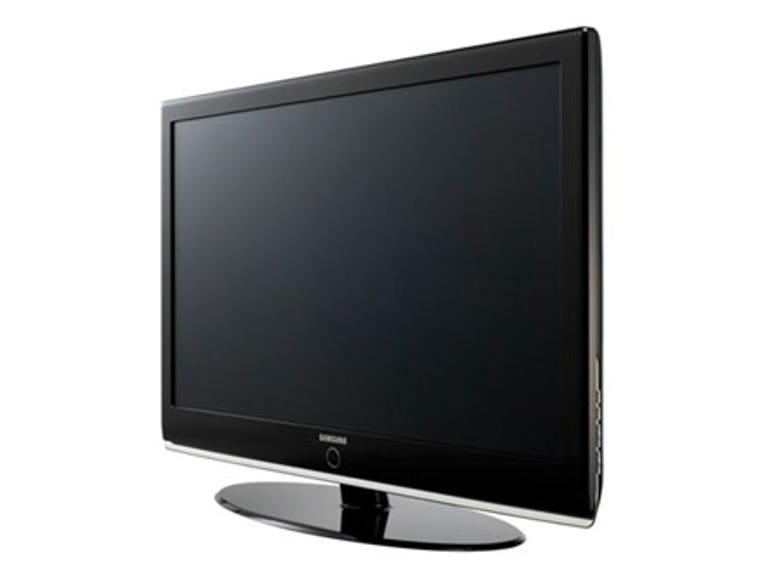 Why You Can Trust CNET
Why You Can Trust CNET Samsung LA46M81BDX review: Samsung LA46M81BDX LCD TV
The Samsung LA46M81BDX is a 46 inch LCD screen with magnificent black levels and a fine picture but it's not the final word on detail.
No-one likes a format war. No-one. And just when we thought we found a winner between LCD and plasma, Samsung go and bugger it all up. The Koreans have attempted to not only up-end the apple cart, but shoot the horse and ride away on the grocer with their new range of LCD screens. The LA46M81BDX is one of these.
The Good
The Bad
The Bottom Line
Samsung may have used a clumsy simile when they said this range was "like a fine bottle of wine" -- because old bottles get better with age instead of being replaced by new ones -- but they sure do have an excellent TV in this 46-incher.
Design
Similar in looks to Samsung's own R8, but less triangular, the LA46M81BDX (or M8 for short) features a rounded design with a piano-gloss finish. The only problem with this design is that it attracts dust like nothing else, and we couldn't find a cleaning cloth in the package -- as some manufacturers kindly supply. Along the bottom of the TV runs what appears to be a Perspex strip, as featured on the R8, but it is instead a subtle metallic -- and therefore slightly reflective -- bar. Very classy.
Users with a large living space will appreciate the swivel base which swings through 30 degrees, and can make watching easier no matter where you are in the room. For added convenience, Samsung also offers a motorised, wall-mounted swivel for an extra AU$900.
The remote control is the same one we've seen previously. It's a decent unit, and includes a backlight button which illuminates the channel and volume buttons. Given that most people now have their own sound systems and sources it would have been nice for the Source button to be illuminated as well.
Features
The M8 is a full 1080p set, and to complement this it comes with an HD tuner. No more messing around with analog, as in the case of last year's S7 series. Samsung's Super Clear Panel technology has seen the dynamic contrast ratio raised to 15,000:1, a significant increase on that of last year's crop. This has resulted in almost pitch-black blacks rather than the slightly murky versions we saw on the 6,000:1 LA40F7.
This TV is one of the few which includes a full three HDMI sockets; two of these are at the rear, and one on the side. This last one is particularly good for short-term connections such as a camcorder or an HDMI-equipped laptop like the Dell XPS M1330.
Like its plasma brother, the Q9, the M8 offers a number of configuration options, including the ability to alter MPEG noise levels and judder issues. However, as we found with the plasma, the proprietary Movie Plus Imaging Engine is pretty bad at resolving most content (as it seems to have been designed for NTSC and makes anything else a jerky mess) and is best turned off. One of the other many configuration options includes enabling black level control for HDMI -- with a choice of Normal and Low. Based on our testing Normal was best -- Low made everything "blacker" but at the expense of detail.
Performance
One common problem the LCDs of the last 12 months have exhibited is a cloudiness, or an inconsistency in the backlighting. This is particularly evident when the screen is black -- this is when the screen appears blotchy as the backlight shines more brightly through in some areas than others. The Samsung, along with the Sharp we saw earlier this year, doesn't have this problem and is consistently lit across the screen.
During testing we found that the M8 behaved more like a plasma than an LCD with a more "filmic" and less "analytical" picture. Viewed side-by-side against the R8 panel, and using the HD tuners onboard both sets, there was a certain softness to the M8, especially with skin -- freckles and wrinkles were much clearer on the cheaper model. Even with the Sharpness control jacked all the way to maximum, there was still less detail in the M8. It would seem as though the designers have sacrificed sharpness for absolute black levels.
However, colour is very good, with a touch of an emphasis on red and blue, but this has the effect of making the picture more vibrant. High definition images via the HDMI input are best served, and a Blu-ray disk such as Mission Impossible III delivers plenty of skin detail on close-ups, but we also noticed a little more digital noise than we liked. We hate to admit it, but the R8 was better here, too.
The Samsung LA46M81BDX is the cheapest 46-inch LCD we've seen yet, and as it's also full HD it also gains points on equivalently sized plasmas (think 50-inch). In terms of absolute detail, this isn't the TV to buy -- Samsung's own R series looks to be the sweet spot for image quality versus financial outlay, even if they're not full 1080p. Yet, that's not to discount the abilities of the M8: it will do full HD, with an amazing amount of black, and displays an even hand with most sources whether standard or high definition.


